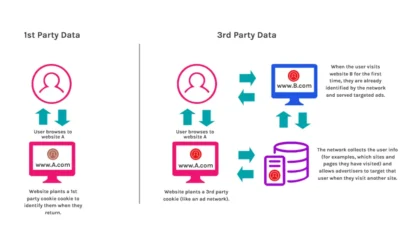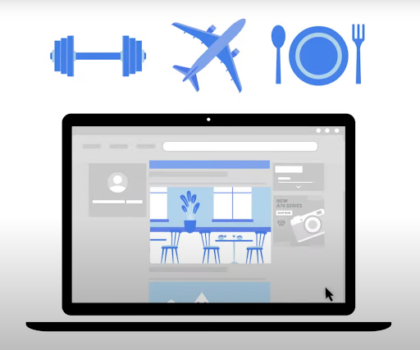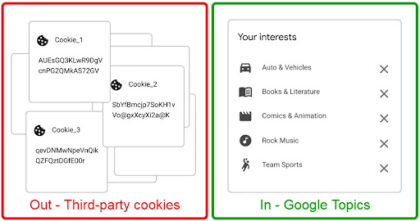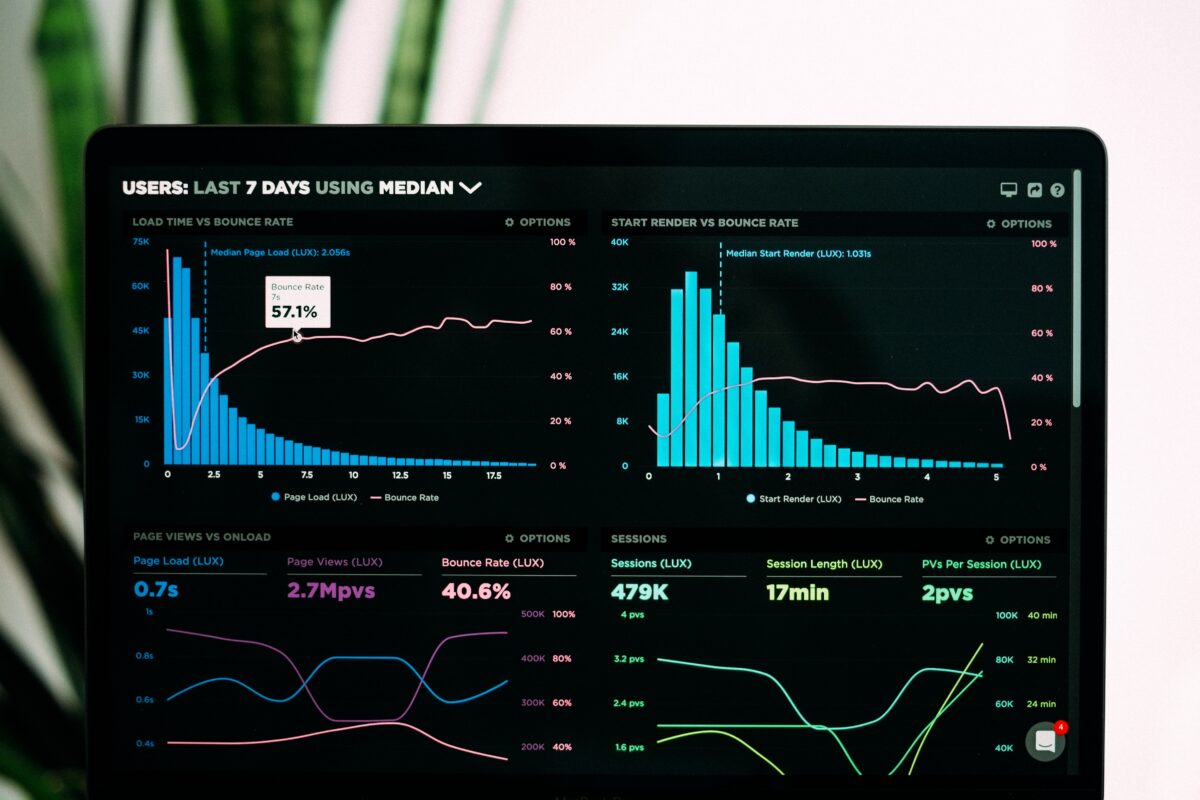After being innocently invented in 1994, the simple web cookie has gone from an invaluable web technology to one of the most controversial features of today’s browsers.
The demise of third-party web cookies
First-party cookies are small text files stored on a user’s computer that can help store preferences, settings, user IDs, or other data from session to session. First-party cookies can only be used by the domain that set them, so they remain private to the rest of the web.
Third-party cookies are shared, persistent cookies that any website can view and gain information from without a user’s consent.
Advertisers (starting with Google’s DoubleClick) realised that third-party cookies can help identify certain individuals, demographics, or users who have visited certain web pages, so adverts can be targeted towards them.

Furthermore, tracking pixels and widgets started passing third-party cookie data back to advertisers, essentially allowing them to track users across multiple websites. This valuable (and often private) data can then be utilised or sold to other advertisers or to marketing analysis firms.
The EU was the first to address this creepy tracking method with the General Data Protection Regulation (GDPR) to give people the right to control what personal data they share with companies. Many other governments have now set their own data privacy laws, including California where Google and many other US tech giants are headquartered.
Despite initial backlash from several advertising giants, Apple has slowly transitioned users into a privacy-first environment on their proprietary Safari browser and App Store.
Google Chrome, the world’s most popular browser announced a transition away from third-party cookies completely, with an end date currently set to late 2024.
How does the loss of third-party cookies impact digital marketing?
At the start of 2024, Google plans to turn third-party cookies off for 1% of users. This is in part to measure its impact on the industry and to also help web developers transition their systems, as some use third-party cookies to create a seamless user experience on multiple domains.
This change will cause financial pains for advertisers to the tune of upto $10 billion in lost advertising revenue per year. Facebook (Meta) has already seen a devastating loss of user data due to Apple’s iOS14 update for example where Facebook App users have to opt-in to being tracked instead of having every message and interaction with the platform tracked by default.
For digital marketers, the first noticeable change is a loss of data in analytics reports such as Google Analytics. Digital attribution was never a silver bullet, and businesses that heavily rely on attribution data from analytical tools are now panicking at the loss of data and which areas to invest in. Google’s shift from Universal Analytics to GA4 attempts to fill in the gaps with predictive analytics and signal data, but it still obscures some valuable first-party data.
The effectiveness of social media has been dampened by the loss of third-party data with ad costs that have nearly doubled in 2022 since Apple upped it’s privacy settings.
Reduced insights into user types, demographics, and user behaviour have also resulted in less effective display and programmatic advertising due to having fewer insights and segmentations.
Remarketing too has been affected with more users denying cookies and similar audiences disappearing from platforms such as Google Ads recently over privacy fears.
What changes are being made to get around this issue?
After over 100 proposals, Google’s main solution to the loss of third-party data is to have a privacy sandbox of universal identifiers they refer to as Google Topics.
 Google Topics is a system that views a user’s browsing history and then tags them with a certain number of groups/categories for any website to see.
Google Topics is a system that views a user’s browsing history and then tags them with a certain number of groups/categories for any website to see.

There have been concerns that Google’s new privacy sandbox is just as invasive as third-party cookies and still does not give the average user full privacy, but this seems to be the way Google and other browsers are proceeding with the loss of third-party cookies.
With these topics in place, a user isn’t officially giving away any personally identifiable data, or using device fingerprinting, they are simply informing advertisers of how best to target ads towards them with ads.
How can digital marketers adapt to this cookieless future?
Advertisers can continue as if it were 2017, but old approaches will dwindle in effectiveness, especially at the end of 2024 when third-party cookies are completely removed.
First-party data
A plethora of untapped conversions can be drummed up using data that you already own, known as first-party data.
You can gain valuable insights into your typical customers such as pain points within your website, and tailor your offering to what people are asking for via email and other communication channels.
Emailers are a surefire way to get eyes on a website, and effective segmentation of users can make each email campaign generate a steady stream of returns.
Offline conversion tracking (OCT) allows you to see which campaigns, sources, or channels are attributed to a qualified lead. Instead of guessing which channels are working for you, OCT and Mix-Media-Modelling can cut out the time-wasters and target just those who are likely to convert down the line.
Zero-party data
If you want personal information from potential customers then you can simply just ask for it.
There are many techniques out there to gain zero-party data, including:
- Quizzes
- Surveys
- Via communication channels
- Competitions
- Etc.
Social media & programmatic advertising
Social media costs may be rising, but their effectiveness is often underestimated in the role they play towards the attribution of a final sale.
Both social and programmatic advertising can hit very precise demographics, and if used wisely can reach the right potential converters when they are in-market.
Influencers on social media have incredibly captivating audiences and can turn an unknown brand into an overnight success just by promoting it to their millions of followers online.
Contextual advertising
Harking back to the old offline days of physical media buying, your brand can be neatly placed alongside the right context on websites via display advertising or via affiliation deals on specialised platforms.
A surprising number of the world’s biggest websites will only allow ads through affiliation and cannot be reached on popular platforms such as Google Ads.
Moving into a cookieless future
Just like Adobe’s Flash player and Netscape’s Plugin API (does anyone remember that?), there will be some major changes to how we all browse the Internet in the upcoming years and we should prepare ourselves ahead of time.
Keep adapting to stay ahead of the competition, and embrace the loss of third-party cookies.





